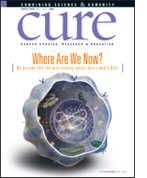Short Schedule Just as Good in the Long Run?
A shorter schedule of radiation therapy may be more convenient and cost effective for women with early-stage breast cancer.
Michigan
Detroit-area radiation oncologist Frank Vicini, MD, would often see women come down from the upper peninsula of to be treated for breast cancer.
"In some cases when patients have to travel a long distance, it can be quite a concern to come back for 25 or 30 treatments of radiation therapy,” Vicini says.
Since many of the patients could not afford to stay in a hotel that long and didn’t want to travel, some opted for a mastectomy at their local hospital, even though they could have had a lumpectomy and radiation. The expense and inconvenience presented a barrier, Vicini says.
Concerned, he started looking into better alternatives for these women. That’s when he learned about accelerated partial breast irradiation.
The idea, explains Vicini, was to give a more intense dose of radiation in a more localized spot for a shorter period of time. Today, women who qualify can finish treatment in five days instead of five or six weeks.
Scottsdale
Arizona
,
Vicini and Robert Kuske, MD, a radiation oncologist from , are pioneers of accelerated and other forms of partial breast irradiation. Their initial research showed it has the same effectiveness as whole breast radiation, and other institutions matched their outcomes. After a successful National Radiation Therapy Oncology Group phase II trial, the National Cancer Institute is now sponsoring a randomized head-to-head comparison to the six-week standard to confirm that local recurrence rates are similar.
University
Michigan
of
Some radiation oncologists, including Lori Pierce, MD, from the , urge caution until the NCI study results are available. Pierce says it pays for women to get all of the information and make a careful decision.
“It’s important when physicians talk with patients they be very clear about what we know and what we don’t know, so they can make a good decision,” she says.
One unresolved question, for example, is whether it is possible for women who do have a recurrence to have additional radiation to the same breast. This will most likely be decided on a case-by-case basis and will depend upon the dose used and the volume of breast and other tissues previously irradiated to determine whether additional treatment can be safely tolerated, Pierce says.
Kuske and Vicini are two of the leaders in the all-important phase III randomized trial.
"We're doing due diligence to definitively establish whether this is an equivalent standard of care," Vicini says. While partial breast irradiation is already popular at many hospitals across the country, Vicini says, "we have to do the right thing scientifically before this is adopted on a wide scale."
